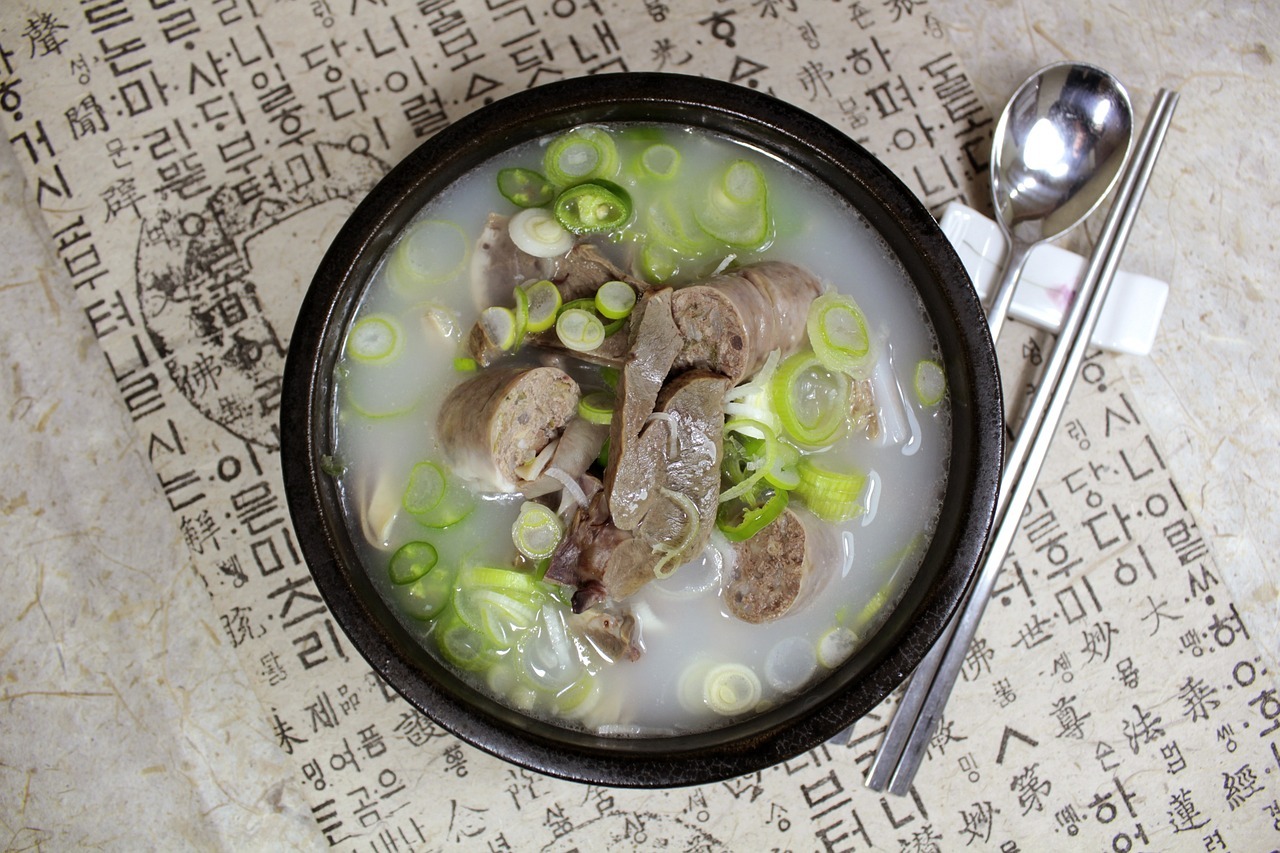Haejang-guk is a traditional hangover soup in Korea. The word Haejung-guk refers to all kinds of guk or soup that are consumed to cure hangover in Korea, and sometimes, it is called sulguk. This soup often consists of vegetables, Napa cabbage, and meat in a beef broth. Seonjiguk is one type of haejang-guk, and it has a slice of firm ox blood. In this article, we are going to know more about haejang-guk and its different types.
History of Haejang-Guk
In a manual for learning spoken Chinese called Nogeoldae, which was published in the late Goryeo Dynasty, the word seongjutang first appeared. The term means soup to get sober, and since then, it has been assumed to be the origin of haejang-guk. According to the manual, the soup consists of noodles, thinly sliced meat, a powder of cheoncho, and scallions all mixed in a beef broth. The ingredients are the same as the basic recipe of haejang-guk today.
Even if haejang-guk is not mentioned in cookbooks that were written during the Joseon Dynasty, there are similar contents can be seen in different documents and genre paintings during the late Joseon dynasty. In a painting called Jumakdo that was done by Shin Yun-bok, you can see a scene wherein the haejang-guk is well depicted. In the painting, you will see a group of unemployed children of the rich eating haejang-gu while a jumo, or a female owner of a tavern, scoops boiling soup out of a large cast-iron pot.
Haejang-guk is not only eaten by commoners. In fact, according to Haedongjukji, which is a collection of poetry that was created by Choe Yeong-nyeon, haejang-guk is also referred to as hyojonggaeng, which is a dawn bell soup. The book says that the area somewhere in Namhansanseoing is known for making that soup well. They mix kongnamul or soybean sprouts, Napa cabbage, abalone, mushrooms, sea cucumber, and galbi together with tojang or a fermented bean paste. They simmer it thoroughly for a day. After that, the soup will be put into a hangari or an earthen crock that is covered with a pad of cotton, and then they send it to Seoul at night. When the dawn bell rings, the soup is then delivered to a house of high-ranking officials. The hangari keeps the soup warm, and it is said that the soup is delicious and useful for curing hangovers.
Types of Haejang-Guk
There are several types of haejang-guk in different regions of Korea. They are all distinguished based on the ingredient and recipe, which gives the soup their own characteristic taste. The Haejang-guk in Seoul is a tojangguk or soybean paste soup that consists of radish, kongnamul or soybean sprout, Napa cabbage, firm ox blood, and scallions. The broth that is used in this soup is prepared by simmering ox bones in a pot of water for a couple of hours.
The city of Jeonju is known for making and eating kongnamaulgukbap as their haejang-guk. This soup is prepared with a little lean kongnamul that is as long as an index finger. They are poached in water that has a small amount of salt. Steamed rice, scallions, sliced ripe kimchi, garlic, a small amount of shank or meat, and beef broth, then it is served in a ttukbaegi, or a small earthen pot is served along with the kongnamul. The pot is served over heat then the kongnamul broth is poured into it. When all the ingredients are boiled, a raw egg will be cracked over the soup. A mixture of scallions, mixed garlic, salt, sesame seeds, chili pepper, and a salted fermented shrimp called saeujeot are put into the soup.
On the other hand, there are also haejang-guk that is served with cold soup. In Uljin County, a soup called ojingeomulhoeguksu is consumed as a haejang-guk. This soup consists of finely sliced squid-like noodles that are mixed with a special sauce is poured along with cold water and ice cubes.
Other haejang-guk recipes are:
- Kongnamulguk – This type of haejang-guk is made with kongnamul or bean sprouts.
- Gulgukbap – This haejang-guk is often made with buchu and oyster.
- Ugeojiguk – This soup is made with outer leaves of Napa cabbage. They call the ugeoji.
- Jaecheopguk – This haejang-guk is made of jaecheop or freshwater clams, and garlic chives.
- Seonjuguk – This soup is often made with seonji or firm ox blood.
